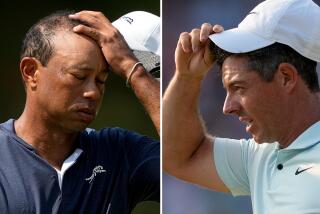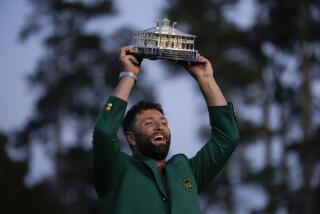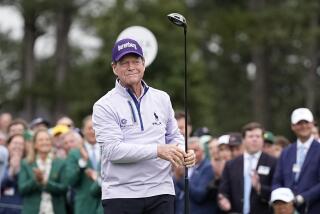Elusive Chase Begins With Masters : First of the Four Majors Signals Start of Grand Slam
AUGUSTA, Ga. — The search for the Holy Grail of professional golf, the elusive Grand Slam, resumes next week at the 50th Masters championship.
In the minds of the purists, the golf season begins at the Masters because it is the first of the four events that make up the Slam, which includes the U.S. Open in June, the British Open in July and the PGA Championship in August.
“Although we’ve been playing golf for three months, for most people, the Masters is the start of the golfing year,” said Jack Nicklaus, who has won more of the major tournaments (17) than anyone else. “Once you win at Augusta, you are the only guy who has a chance to win all four of them.”
This year, there is no clear-cut favorite for the Masters. If you were pressed to pick one, you’d probably go with a foreigner--either Seve Ballesteros, a Spaniard who doesn’t play as a regular on the PGA Tour because of tax problems, or defending champion Bernhard Langer of West Germany.
Ballesteros, who also has won two British Opens in recent years, won the Masters in 1980 and 1983 and was tied for second last year, two shots behind Langer. Langer is fourth on the PGA Tour money list, although he hasn’t won in the United States so far this year.
The closest anyone has come to to winning all four Grand Slam tournaments was in 1953 when Ben Hogan won the Masters, the U. S. Open and the British Open. Hogan didn’t play in the PGA Championship that year because of a schedule conflict with the British Open.
Nicklaus made a run at the Grand Slam in 1972 when he won the Masters and the U.S. Open. That bid ended when he was runner-up to Lee Trevino in the British Open. And the last time a golfer won two Grand Slam events the same year was in 1982 when Tom Watson won the U.S. and British opens.
Time was when Nicklaus and Watson were virtually automatic favorites at the Masters because the famed Augusta National, with its wide-open fairways and huge, undulating greens, was tailor-made for their game.
But Nicklaus, a five-time champion, is now 46 and hasn’t won since 1975. And although Watson is 10 years younger, he hasn’t won since 1981.
In the past, the dominant Masters players went in cycles--Sam Snead and Ben Hogan in the late ‘40s and early ‘50s, Arnold Palmer in the late ‘50s and early ‘60s, Nicklaus from the early ‘60s to the mid-’70s.
This year’s top two money leaders--John Mahaffey and Calvin Peete--have had little luck in the Masters.
Mahaffey, who became leading money winner with $244,736 when he came from behind last Sunday to win the Tournament Players Championship, has been no better than a tie for eighth in his nine previous Masters appearances. And Peete, No. 2 money winner with $230,598, tied for 15th in the best showing of his six tries at Augusta.
“My goals are to win some major championships and another million dollars.” said Peete, who has won 11 of his 12 Tour victories and nearly $1.5 million in just the past four years. “But, the Masters course is not suited for my game, although I feel I can win there if I have a hot hand that week. My lack of winning any of the other major championships is due to my lack of experience while playing most of those courses for the first time.”
Watson, who tied for 10th last year in his poorest Masters showing in six years, is unhappy with the way he has been playing, especially with his putting, but he feels he shouldn’t be written off this year.
“Returning to Augusta will help,” he said. “When you are at a course where you have played well in the past, it gives you a good feeling when you stand on the first tee.”
“There are maybe 20 to 25 who have a chance to win compared to 40 to 50 at a normal Tour event,” said Nicklaus, referring to the fact that the 90-man Masters field is about 60 less than at the regular stops and includes some amateurs and foreigners who wouldn’t be included on the Tour. “There are fewer players that have a chance than anywhere else.”
The Masters is the only Grand Slam event always played on the same course. There are plenty of tournaments with bigger purses, stronger fields, more demanding courses. But none with the legacy left by the legendary Bobby Jones.
“You don’t just create a major championship (as PGA Commissioner Deane Beman would like to do with the TPC),” said Nicklaus. “But the media has made it bigger than life and as the tradition grew, so did the tournament. We (the golfers who play in it) now consider it as a pivotal point of our year. It is the first of our four majors, so it carries a special meaning beyond its own mystique.”
Whatever, the azaleas and dogwoods are in bloom at the Augusta National where Nicklaus always arrives early, and where Gene Sarazen, who rode a double-eagle to victory more than a half century ago, holds court on the magnolia-shaded clubhouse porch.
And, although competition doesn’t begin until Thursday, many of the expected 50,000 spectators will show up for the Monday-to-Wednesday practice rounds, because, to them, the Masters is as much a social event as a golf tournament.
More to Read
Go beyond the scoreboard
Get the latest on L.A.'s teams in the daily Sports Report newsletter.
You may occasionally receive promotional content from the Los Angeles Times.










